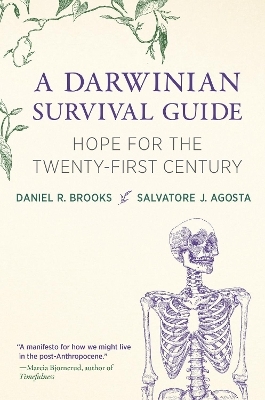
A Darwinian Survival Guide
MIT Press (Verlag)
978-0-262-04868-2 (ISBN)
Despite efforts to sustain civilization, humanity faces existential threats from overpopulation, globalized trade and travel, urbanization, and global climate change. In A Darwinian Survival Guide, Daniel Brooks and Salvatore Agosta offer a novel—and hopeful—perspective on how to meet these tremendous challenges by changing the discourse from sustainability to survival. Darwinian evolution, the world’s only theory of survival, is the means by which the biosphere has persisted and renewed itself following past environmental perturbations, and it has never failed, they explain. Even in the aftermath of mass extinctions, enough survivors remain with the potential to produce a new diversified biosphere.
Drawing on their expertise as field biologists, Brooks and Agosta trace the evolutionary path from the early days of humans through the Late Pleistocene and the beginning of the Anthropocene all the way to the Great Acceleration of technological humanity around 1950, demonstrating how our creative capacities have allowed humanity to survive. However, constant conflict without resolution has made the Anthropocene not only unsustainable, but unsurvivable. Guided by the four laws of biotics, the authors explain how humanity should interact with the rest of the biosphere and with each other in accordance with Darwinian principles. They reveal a middle ground between apocalypse and utopia, with two options: alter our behavior now at great expense and extend civilization or fail to act and rebuild in accordance with those same principles. If we take the latter, then our immediate goal ought to focus on preserving as many of humanity’s positive achievements—from high technology to high art—as possible to shorten the time needed to rebuild.
Daniel R. Brooks is Professor Emeritus, University of Toronto, Senior Research Fellow, H. W. Manter Laboratory of Parasitology, University of Nebraska State Museum, and Fellow of the Stellenbosch Institute for Advanced Study (STIAS). He is the coauthor of The Stockholm Paradigm and The Major Metaphors of Evolution. Salvatore J. Agosta is Associate Professor at Virginia Commonwealth University and Fellow of the Stellenbosch Institute for Advanced Study. He is the author of more than fifty scientific publications and coauthor of The Major Metaphors of Evolution: Darwinism Then and Now.
CONTENTS
PREFACE vii
1 INTRODUCTION 1
2 HOW DOES NATURE WORK? INHERITANCE SYSTEMS 15
3 HOW DOES NATURE WORK? ECOSYSTEMS 39
4 HUMANS: THE EARLY DAYS 59
5 THE LATE PLEISTOCENE: THE RISE OF HOMO SAPIENS 79
6 AFTER THE ICE AGE: THE GREAT TRANSITION 89
7 THE NEOLITHIC PERIOD: THE GREAT AMPLIFICATION 101
8 INSTITUTIONALIZING SOCIETY: THE GREAT TRAGEDY 117
9 OVERSPENDING AS A WAY OF LIFE: INFLECTION AND ACCELERATION 145
10 HOW HUMANS SHOULD INTERACT WITH THE REST OF THE BIOSPHERE 165
11 CONVIVIAL CONSERVATION IN AN EVOLUTIONARY COMMONS: COSTA RICA’S GREEN PHOENIX 193
12 HOW HUMANS SHOULD INTERACT WITH EACH OTHER 205
13 HOW HUMANS SHOULD INTERACT WITH THEIR INSTITUTIONS 231
14 AUTUMN OF THE ANTHROPOCENE: HOPE FOR NOW, HOPE FOR THE FUTURE 255
ACKNOWLEDGMENTS 271
SELECTED READINGS 273
INDEX 335
| Erscheinungsdatum | 26.01.2024 |
|---|---|
| Zusatzinfo | 19 BLACK AND WHITE ILLUS. |
| Sprache | englisch |
| Maße | 152 x 229 mm |
| Themenwelt | Naturwissenschaften ► Biologie ► Evolution |
| Naturwissenschaften ► Biologie ► Ökologie / Naturschutz | |
| Naturwissenschaften ► Geowissenschaften ► Geografie / Kartografie | |
| ISBN-10 | 0-262-04868-X / 026204868X |
| ISBN-13 | 978-0-262-04868-2 / 9780262048682 |
| Zustand | Neuware |
| Haben Sie eine Frage zum Produkt? |
aus dem Bereich


